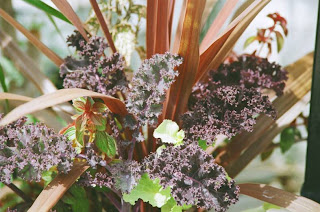
Acomplished gardener Margaret Wilke graciously invited Russ Henry, owner of Giving Tree Gardens, into her home for tea, cookies, and a plate full of garden talk early this January. Here are some excerpts from that garden chat.
Russ-“ I remember when we began working together you were a bit nervous about certain aspects of this project, what was it that made you nervous and how have things turned out?”
Margaret- “Well it was quite a big space and I wondered if it might be too much work. Could I make it look nice? It was just a bigger project than I had ever tackled before. I still have aesthetic concerns about how to balance things out, but I feel more comfortable now that I won’t make too many big mistakes.
If I do, . . . Oh, well.”
R-Well, we’ve still got shovels!!
M-“Yes, that’s right! The front yard was a bit of a surprise to me. I didn’t realize how different gardening in the front yard is from gardening in the back yard! In the back yard you’re kind of doing your own thing. You don’t worry if your hair’s looking crazy. In the front yard it’s a whole different deal! The whole world is out there having a good time watching you! I remember one guy in a pick-up truck who rolled down his window and said, “Hey I like your garden, but I don’t like where that plant is over there.”
R-“Drive by criticism? Well that’s one way to meet a neighbor.... Did gardening in the front yard help you connect with other gardeners in the neighborhood, aside from the drive by type?"
M-“There are two other front yard gardens just half a block down. One fellow has quite a few native plants in his front garden. This was my first year out there in the front. I think next year we’ll probably end up sharing plants. That would be fun!"
R-"Can you gage what kind of effect your new garden has had on the neighborhood as a whole?"
M-“Oh my goodness! It’s fun! … People really raved about it! The neighborhood is very enthusiastic about it, which is just great…. I had a whole contingent of people from the annual neighborhood picnic that wanted a tour and they came over right then!"
R- "We used a whole lot of compost in this garden, and at first you wondered if we needed as much as we were using, how did that turn out?"
M-“Well, as I’ve told you before, the compost saved the day, especially since we had such a hot dry summer. We ended up using 11 yards of compost in the front yard! We are on what’s called the Anoka Sandplain here. We have about two inches of topsoil, and then sand, sand, sand as far as you down as you can dig. Water, of course, just runs right through it. When it did finally rain, the compost just soaked it up like a sponge, which was great! Then it held the moisture so that even though it might seem dry on the surface, if I got down into it, [the soil] would still be moist underneath. I did break down and water occasionally during the hot dry spells, but not nearly as much as I would have to if we had just put a little bit of compost on the surface of all that sand. I also used quite a bit of my own compost when I planted things.
My family considers me a little bit over the top about my compost. When you make your own compost it has eggshells, coffee grounds, broccoli stems, plus all the spent flower stems and other green material from the garden in it. There’s more variety of nutrients in it than in the bulk-produced compost that’s mostly leaves and manure. When I plant something, particularly perennials, I always put some of my own compost in with it. I never have enough! It’s amazing how fast it goes. My family knows that if anybody’s caught dropping a banana peel in the trashcan instead of into the compost bucket, they’re in REAL trouble!! My husband will attest to that.”
R- “Any big plans for next season? What’s going to happen out there?”
M-“I want to make the new garden bigger. I still think there’s too much grass! I would like to figure out how to create more of a framework of evergreen material around which I plant annuals and perennials. The challenge with such a big public prominent garden is how to get it to look like something in the winter. It needs more structure, more architectural pieces. Figuring that out will be my next challenge.”
R-“What words of garden wisdom could you share with a less experienced gardener such as myself?”
M-“Don’t be afraid of making mistakes. They are just part of learning. Even with experience there are always surprises. Sometimes a plant that has done well for years will “croak” for no explainable reason. The one right next to it might be fine. Then a plant you thought was a “goner” suddenly flourishes. It’s just that there are so many variables. Light, moisture, bugs, timing of the heat or cold. There are a lot more things going on than we know about. The mystery of it is wonderful, if you just accept that there’s going to be a lot that is unexplainable. It’s not fully predictable. If you want fully predictable, then . . .”
R-“Rock mulch?”
M-“Yeah, that or the standard fare. But that’s not for me . . .
I need surprises.”







 11:24 AM
11:24 AM
 Rooster
Rooster






















